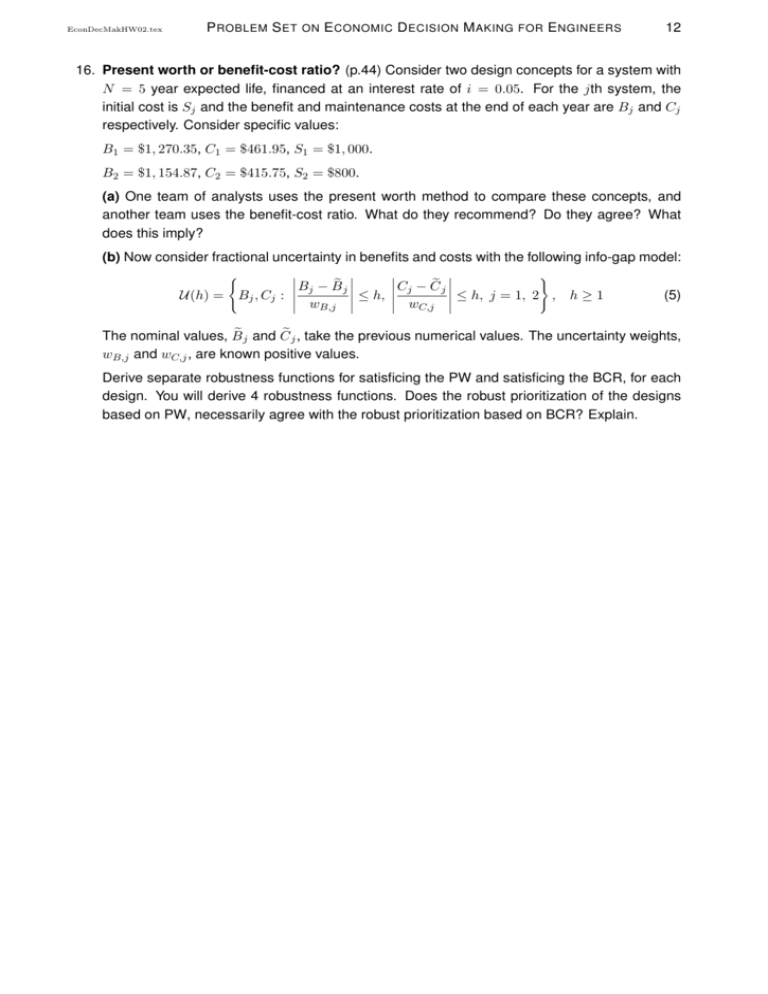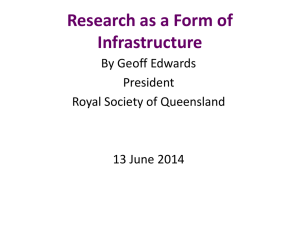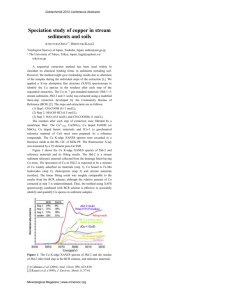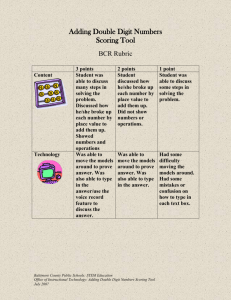Statement and solution of problem 16 in the homework exercises file
advertisement

EconDecMakHW02.tex
P ROBLEM S ET
ON
E CONOMIC D ECISION M AKING
FOR
E NGINEERS
12
16. Present worth or benefit-cost ratio? (p.44) Consider two design concepts for a system with
N = 5 year expected life, financed at an interest rate of i = 0.05. For the jth system, the
initial cost is Sj and the benefit and maintenance costs at the end of each year are Bj and Cj
respectively. Consider specific values:
B1 = $1, 270.35, C1 = $461.95, S1 = $1, 000.
B2 = $1, 154.87, C2 = $415.75, S2 = $800.
(a) One team of analysts uses the present worth method to compare these concepts, and
another team uses the benefit-cost ratio. What do they recommend? Do they agree? What
does this imply?
(b) Now consider fractional uncertainty in benefits and costs with the following info-gap model:
}
C − C
B − B
e j e j j
j
Bj , C j : ≤ h, ≤ h, j = 1, 2 ,
wC,j wB,j {
U(h) =
h≥1
(5)
e j and C
e j , take the previous numerical values. The uncertainty weights,
The nominal values, B
wB,j and wC,j , are known positive values.
Derive separate robustness functions for satisficing the PW and satisficing the BCR, for each
design. You will derive 4 robustness functions. Does the robust prioritization of the designs
based on PW, necessarily agree with the robust prioritization based on BCR? Explain.
EconDecMakHW02.tex
P ROBLEM S ET
ON
E CONOMIC D ECISION M AKING
FOR
E NGINEERS
44
Solution to Problem 16, Present worth or benefit-cost ratio? (p.12).
(a) Present worth of the benefits of design j are:
N
∑
Bpw (j) =
(1 + i)−n Bj
(128)
n=1
1 − (1 + i)−N
Bj
i
= δf (i)Bj
(129)
=
(130)
Present worth of the initial investment and maintenance costs of design j are:
Cpw (j) = Sj +
N
∑
(1 + i)−n Cj
(131)
n=1
1 − (1 + i)−N
Cj
i
= Sj + δf (i)Cj
(132)
= Sj +
(133)
The present worth of design j is:
PWj = Bpw (j) − Cpw (j) = δf (i)Bj − Sj − δf (i)Cj
(134)
The BCR of design j is:
BCR(j) =
=
Bpw (j)
Cpw (j)
δf (i)Bj
Sj + δf (i)Cj
(135)
(136)
The discount function is δf (i) = 4.3295. Thus:
Bpw (1) = $5, 500, S1 +Cpw (1) = $1, 000+$2, 000 = $3, 000. Thus PW(1) = $2, 500 and BCR(1) =
1.8333.
Bpw (2) = $5, 000, S2 + Cpw (2) = $800 + $1, 800 = $2, 600. Thus PW(2) = $2, 400 and BCR(2) =
1.9231.
Hence: PW(1) > PW(2) so design 1 is PW-preferred.
But: BCR(2) > BCR(1) so design 2 is BCR-preferred.
The teams disagree. Objective economic analysis is not always unique.
(b) The robustness function for the PW of design j is defined as:
{
(
b
hpw,j = max h :
)
min
B,C∈U (h)
}
≥ PWc
PWj
(137)
where PWj is specified by eq.(134).
The robustness function for the BCR of design j is defined as:
{
b
h
bcr,j
= max h :
(
)
min
B,C∈U (h)
BCRj
}
≥ BCRc
(138)
where BCRj is specified by eq.(136).
b pw,j . Similarly, let m
Let mpw,j denote the inner minimum in eq.(137), which is the inverse of h
bcr,j
b
denote the inner minimum in eq.(138), which is the inverse of h
bcr,j .
EconDecMakHW02.tex
P ROBLEM S ET
ON
E CONOMIC D ECISION M AKING
FOR
E NGINEERS
45
Both of these inverses occur, at horizon of uncertainty h, for:
e j − wB,j h,
Bj = B
Cj = Ce j + wC,j h
(139)
Thus:
g − h(w
e j − wB,j h)δf − Sj − (C
e j + wC,j h)δf = PW
mpw,j = (B
j
B,j + wC,j )δf ≥ PWc
(140)
Hence:
b pw,j =
h
Similarly:
mbcr,j =
g − PW
PW
j
c
(wB,j + wC,j )δf
e j − wB,j h)δf
(B
Sj + (Ce j + wC,j h)δf
≥ BCRc
(141)
(142)
Hence:
b
h
bcr,j =
g − BCR )(S + C
e j δf )
(BCR
j
c
j
(wB,j + wC,j BCRc )δf
(143)
The nominal values are the same as before, so the nominal prioritization disagrees between PW
and BCR:
g
g
g > PW
g
PW
(144)
1
2 but BCR1 < BCR2
However, the costs of robustness (slopes of the robustness functions) for PW and BCR depend
differently on the parameters. Thus there may be curve-crossing and preference reversal for one
criterion (PW or BCR) but perhaps not for the other. Also, the critical values at which curve crossing
occurs may be interpreted differently for the two criteria. Thus the robust prioritization based on PW
may or may not agree with the robust prioritization based on BCR.






